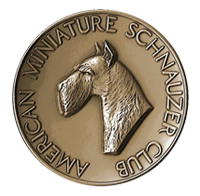The well-proportioned compactness of the Miniature probably has much to do with the popularity of the breed, although many fanciers will say that it is his excessively happy and friendly disposition and adaptability as a house pet. The heavy beard that all but hides the muzzle of the Miniature Schnauzer provides him with a comic opera mask behind which he can plan his endearing mischief undetected.
The origin of the Schnauzer is considered as being a cross between the “dog of Boulogne” and the Spitz. The oldest German Kennel Club was founded in 1890. The following year at the Third German International Show in Hanover, with about 900 dogs, wirehaired Pinschers of German breeding were exhibited for the first time. A dog “Schnauzer” won first prize exhibited by the Württemberg Kennel of Burgerbeonberg.
Previous to any show debut, however, the Schnauzer had a long history. There is no question of its being a breed of great antiquity.Albrecht Durer depicted a Schnauzer in a water color “Madonna with the Many Animals” executed in 1492. In a tapestry made about 1501, a representation of the Schnauzer appears.
The Schnauzer (the breed with a beard on the muzzle, the German word for muzzle being schnauze) was used extensively in Germany as a drover’s dog, used to pull carts with produce from the farms to the towns, and guard them while there. He was used as well in herding sheep, cattle, and hogs, and, in fact, doing all the duties of the regulation farm dog. He was also used extensively as a rat catcher, and even in modern times, German Schnauzer Clubs hold periodical “ratting” trials in order to keep the Schnauzer a “working” breed, and not merely a show dog.Here in the U.S., Schnauzers can be seen working in Barn Hunt and Earthdog Trials. The Miniature is an especially good ratter!
The Miniature is said to have come from mating with the Affenpincher. They may have been developed entirely by chance, often the main reason for a new breed.In any case, it has taken its niche in life, both as a show dog, a performance competitor, and as a desirable house pet. Good health, good temperament, and an attractive appearance combine to form the personality of the Miniature Schnauzer. They have been bred for over 116 years and were exhibited as a distinct breed as early as 1899. Miniatures have been bred in the United States since 1925 and the American Miniature Schnauzer Club was formed in August 1933. The Miniature Schnauzer was officially recognized by the AKC in 1926.

